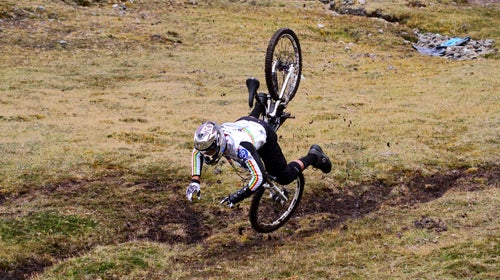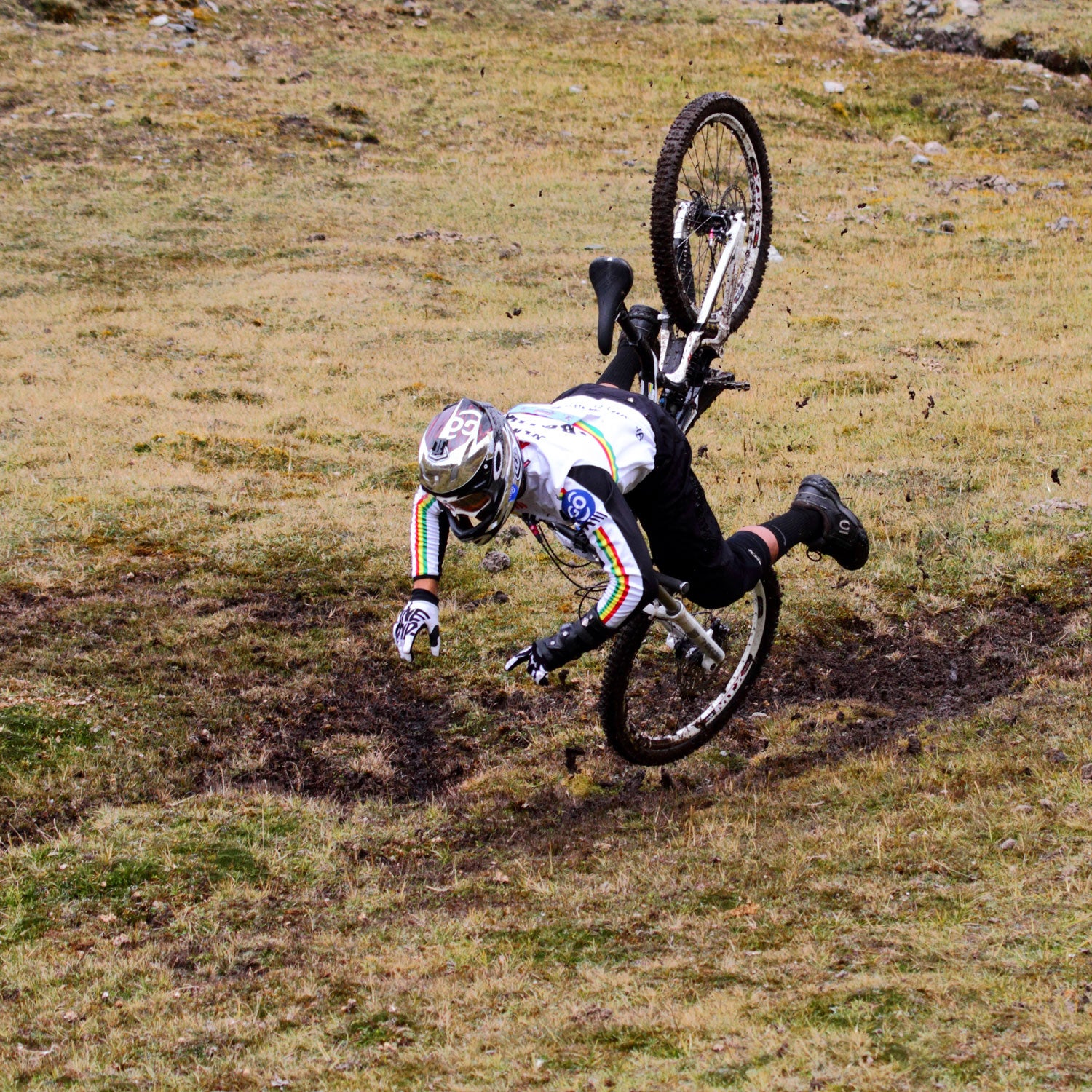Global experts on how outdoor athletes stumble, trip, twist, crash, snap, pop, tear, and occasionally croak in hard-to-reach places , courtesy of the University of ColoradoтАЩs sports medicine department. The mission? Bring practitioners up to speed on the many methods weтАЩve invented to destroy our bodies, so they can be prepared when they wheel in another human pretzel in a helmet. HereтАЩs a primer.
Deep Diving
At a depth of 30 meters, a diverтАЩs lung volume is a quarter of what it is at the surface and, like a sperm whale, continues to compress the deeper you go. For a dive of 100 meters, your tank is a complicated mix of gases thatтАЩs only 10 percent oxygen. If you breathed that same air at the surface, youтАЩd die. Dive deeper than 400 feet and you need a battery of tanks with specific gas mixture recipes. Get it wrong and you die. All of which is why, while 100-meter dives are now routine, only three people have dived deeper than 800 meters and lived.
Heard: тАЬWith freediving, consciousness is the key to success.тАЭ
The Velodrome
The biggest risks for track cyclists are to the clavicle and wrist, thanks to what the Brits call тАЬargy-bargy,тАЭ the elbowing and headbutting employed to fight for position in a sprint. Also, track cyclists have a hard time buying pants.
Climbing
Fifty-two percent of climbing injuries are to the fingers.
Seen: An image of a тАЬsheathedтАЭ finger was presented, in which all the skin and much of the meat from a central digit were unrolled past the knuckle and tucked up by the fingertip like a baggy knee warmer.
Rodeo
Horses are prey animals, so when a predator climbs on an unbroken horseтАЩs back, the horse gets scared and flips over to try and squash it. Other common rodeo injuries include being stepped on hard enough to rip paisley and crack ribs, blowing an ACL while wrestling a steer to the ground, suffering an тАЬopen book pelvisтАЭ fracture from sliding forward on the spine of a thousand-pound beast, and a new one, thanks to helmet use: When a bullтАЩs horns strikes the helmet, it spins on the head, shredding ears like a juicer. A rodeo docтАЩs common refrain: тАЬIt hurts because itтАЩs still broken, but youтАЩre riding anyway.тАЭ
Heard: тАЬWe determined the patient was titanium deficient.тАЭ
Formula 1 Racing
The average Formula 1 driver is 5'9″ and weighs 145 pounds, withstands more Gs than a space shuttle astronaut, and will peg his heart rate at 180 beats per minute for two hours at a time. Shorter stature is a plus, because the head is the highest part of the car, but itтАЩs still only three feet off the tarmac, where itтАЩs exposed to deadly flying debris from wrecks.
Kite Sports
According to a crack team of European researchers, most deaths in kite sports are attributed to gusts.
Extreme Swimming
Three ways you might die:
1. You get too close to a cargo shipтАЩs wake, which churned up cold water from below, causing hypothermiaтАФand you drown.
2. You drink Gatorade instead of plain water on an open-ocean swim, and the excess salt in your system stops your heartтАФand you drown.
3. You forget to load buckets of blood on the chase boat to keep the piranha behind you. They catch upтАФand you drown.
Skydiving
An orthopedist once jumped from a plane, hit terminal velocity of 120 miles per hour, and deployed his chute, and the forces dislocated his shoulder. While avoiding тАЬbrowning outтАЭтАФitтАЩs common to toy with a loss of consciousness when the canopy decelerates youтАФhe popped (the technical term is тАЬreducedтАЭ) his shoulder back into place mid-flight and landed safely.
Skiing
Injury rates in racing are directly linear with speeds. The downhill is more dangerous than the super-G, which is riskier than the GS, and so on. ThatтАЩs weirdly obvious to a layperson, but the slalom can be rough on knees, so it took some sussing out. Also: It took 20 years for researchers to prove that ski helmets reduce head injuries by 75 percent because the early adopters of helmets were more safety conscious than most skiers.
Heard: тАЬEngineers are better than doctors because they fix problems, whereas doctors fix people hurt by problems.тАЭ
Endurance Sports
The medical brief for the Leadville 100 is 30 pages long, includes detailed descriptions about what to do in cases of acute mountain sickness and hyponatremia (too much water, too little salt), and helps responders know the client: Type A personality; fetish-like desire to finish.
Heard: тАЬWhat happens when you tell a runner not to run? They find another practitioner.тАЭ (This joke killed it with the physical therapists.)
Olympic Ski and Snowboard Cross
At the Seoul Olympics, competitors suffered 14 season-ending injuries and four potential career-enders.
Heard: тАЬI fixed the tar out of that clavicle.тАЭ
X Games
After a surgeon wired a freestyle snowboarderтАЩs jaw shut, the athlete informed him that he was returning to competition. The problem? A subsequent crash could make him unable to breath. So the surgeon made him a necklace with miniature wire cutters as the pendant.
Heard: тАЬThese are not preferred postoperative management techniques.тАЭ
Seen: Video of motocross star Eli Tomac (the son of Mountain Bike Hall of Famer John) stuffing the front wheel of his machine so hard that the twisting action of the handlebars dislocated one shoulder to the anterior and the second to the posterior.
Heard: тАЬOoh.тАЭ
Mixed Martial Arts
тАЬThe main goal of MMA is to induce a head injury,тАЭ said a doc with mad jujitsu skills. On average, MMA fighters sustain 2.5 severe blows to the headтАФafter theyтАЩve been knocked out.
Field Management
A famed orthopedic surgeon with a background in wilderness medicine who has worked at Everest Base Camp once learned how to do a tooth extractionтАФvia sat phone. тАЬMy Leatherman tool came in handy that day.тАЭ
Swimming with Naegleria fowleri
Head to a stagnant pool in Texas or Florida, drink the tepid water, and the brain-eating bacteria wonтАЩt bother you. Get a little of that water in your nasal passages, though, and youтАЩre in trouble. ThatтАЩs where the little amoeba passes through to the skull cavity and eats your brain. Symptoms show up one day to two weeks after exposureтАФand then youтАЩre dead within three days. Naegleria fowleri has killed at least 300 Americans and is all over the otherwise deadly hot springs in Yellowstone. ItтАЩs also been found in Minnesota. тАЬThe CDC likes to say itтАЩs rare, but itтАЩs not,тАЭ says the doc who has helped raise awareness of the killer globally. тАЬIn Africa, thousands are dying from it, but the cause of death is misdiagnosed.тАЭ
Wilderness Medicine
Even the experts get it wrong. What one wilderness doc thought was a simple rash or possibly the shingles on the top of his foot was actually a horde of cutaneous larva picked up while playing beach volleyball on the banks of the Amazon.
Seen: An image of the little critters burrowing around.
Heard: тАЬEww.тАЭ
Yoga
Forty-eight percent of yoga injuries happen to those under age 18. Teenagers and kids, Canadian researchers say, should not be doing yoga. So what then? Hockey?
First Aid
A new device called a REBOA holds the promise of saving lives from rapid blood loss. To use it in the field, simply insert a catheter into the femoral artery and up to the heart, where you occlude the aorta.
Seen: Full-screen image of a man with a stick as thick as a rattlesnake penetrating his neck.
BASE Jumping
Seventy-two percent of BASE jumpers have witnessed a death or a severe injury.
Heard: Reporter had to depart before the question тАЬare BASE jumpers insane?тАЭ was resolved. But weтАЩre going with тАЬyeah.тАЭ


